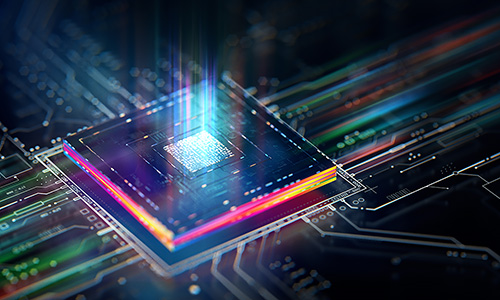Next-Generation Computing Enablers
Want more free featured content?
Subscribe to Insights in Brief

A combination of materials science advances, AI tools, and low-cost hybrid quantum computers could dramatically accelerate the computational power for the next several generations of computer and Internet gear. Breakthroughs could impact all segments of the computing market—from the largest datacenter servers to the smallest handheld devices.
A dramatic acceleration of computational power could drive rapid progress in advanced digital applications, including those using artificial intelligence. Even small devices such as sensors might become able to perform complex data processing, and the largest data centers might be able to run systems that begin to approximate artificial general intelligence.
Computational power breakthroughs could also disrupt competition between firms and between regions—as varied players are able to use the innovations in to catch up with their competitors. Such disruption could, for example, reduce the effectiveness of the United States' attempts to restrict China's access to the most advanced computing hardware. China, Russia, and other countries that face difficulties in accessing advanced computing hardware might be able to use automated design and manufacturing, along with other emerging technologies, to create advanced semiconductors that perform similarly to those from the United States.
Whatever the outcomes, varied technology developments do suggest that a dramatic acceleration of computational power is plausible. One potential breakthrough is the impact that AI will have on chip design and fabrication. With the aid of OpenAI's ChatGPT, a team of researchers from New York State University recently designed and manufactured a working semiconductor chip using only plain English. Previously, semiconductor manufacturers had linked systems for design and automated manufacturing—but such systems always required a specialized hardware definition language. Although the New York State University system is only element of a complete computer processor chip, the researchers' process could eventually scale up to fully automate chip design and manufacture.
Simpler automated chip design tools are also making fully automated chip design and manufacturing more plausible. Already, several commercial Electronic Design Automation tools use AI, and have shown impressive results in chip layout and other elements. Tools such as Synopsys' DSO.ai typically help human chip designers quickly iterate through design options (rather than automating the design process outright), but further improvements could reduce or eliminate the need for human supervision.
If fully automated chip design and manufacture did arrive, it would be a highly disruptive development. Today, chip design and manufacturing are specialized and tightly controlled fields. Emerging technology could change all that, opening up the power to design and manufacture advanced semiconductors to anyone with sufficient motivation. The development would create opportunities, disrupt competition, and perhaps raise security issues; for example, terrorists could design and manufacture custom chips that help them disrupt critical infrastructure.
Some signs exist that automated design and fabrication methods might also transform quantum computing. In one example, the Chinese company, Hefei Origin Quantum Computing Technology, recently launched a platform that can help speed up the production of quantum chips. The NDPT‑100 platform uses nondestructive electrical probing to gauge qubit resistance on qubit chips, accurately and speedily identifying the quality of quantum chips.
Quantum computing could also become more practical—and cheaper—than it is today through hybridization with conventional computers. Although full-scale quantum computing remains the goal of many research teams—and may well yield disruptive breakthroughs—the goal remains long-term. In the short and medium term, hybrid quantum computers could have real industry impact. Rather than waiting for quantum computers to be perfect, these systems augment current quantum computers with conventional computer systems. Typically, the conventional system provides the high-level application logic and user interface, and the quantum computer performs only the calculations where it outcompetes the conventional system.
New materials and manufacturing approaches could also improve the practicality of quantum computers. For example, researchers at Minnesota School of Physics and Astronomy have successfully demonstrated a new diode made using superconductors. In experiments, the tunable device exhibited close to the highest energy efficiency possible. The researchers hope the research could lead to components that help scale up current quantum computers.
Materials and process breakthroughs are also occurring in conventional chip design, again signaling the potential for a dramatic acceleration in computing power. SoC1386 — Breakthroughs for Future Semiconductors details various signs of change. These include Nvidia Corporation reducing the processing time of the inverse-lithography chip-making step and Massachusetts Institute of Technology researchers' demonstrating that manufacturers may be able to aggregate or grow components directly on silicon wafers and apply them to computer chips.
In isolation, any one of these technology and process advances could transform the performance of future semiconductors. In combination, materials science advances, AI tools, and hybrid-low-cost quantum computers could be highly disruptive and lead to societally disruptive improvements in computing power. Stakeholders should monitor events carefully.